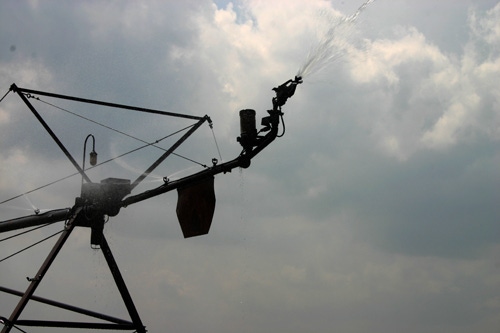June 9, 2011

For Arkansas farmers pushing ahead with this year’s crop, a long stretch of hot, dry weather means two steps forward and one step back.
Growers are irrigating, but “the water is going backwards,” said Brent Griffin, Prairie County Extension staff chair for the University of Arkansas Division of Agriculture. “’Water going backwards’ is slang for when heat and wind evaporation equals the amount of water being applied – you simply cannot keep up.”
Griffin said reservoirs filled during the spring’s relentless rain “will not be full long.”
“We’re seeing in rice problems on clay soil with the rice dying,” said Stewart Runsick, Extension rice verification coordinator with the University of Arkansas Division of Agriculture. “It's actually being choked off because the soil dries so rapidly and the rice only has shallow roots.”
Arkansas’ corn crop is approaching a critical time: pollination. Heat can lead to sterilization and no corn.
“In Phillips County, the only crop where heat is a problem is corn, which might be pollinating,” said Robert Goodson, Phillips County Extension agent.“The corn here is starting to tassel so pollination is not an issue yet; but, if it stays hot it might be.”
The forecast from National Weather Service at Little Rock forecast calls for a steady diet of sun and highs in the 90s through June 14.
The June 6 crop report from the National Agricultural Statistics Service, heat advisories were issued for many counties in the state the last days of May and first few days of June. Highs ranged from 92 degrees at Fayetteville to 101 degrees at Keiser and Eudora. Low temperatures ranged from 60 degrees at Brinkley to 72 degrees at North Little Rock.
The hot, dry weather is an advantage for one set of growers, the winter wheat farmers.
“These conditions are exactly what our wheat needs right now,” said Scott Stiles, Extension economist-risk management. “Harvest progress has moved from 8 percent last week to 25 percent this week, which matches the five-year average.
“It looks like we need a quick finish on wheat harvest to shift the focus over to irrigation. Also, we could be staring at a tough start for double crop soybeans -- irrigating to get a stand or waiting for a rain.”
According to Stiles, some growers south of Interstate 40 are irrigating recently-planted fields to get a stand.
According to the U.S. Drought Monitor, drought conditions are creeping back in to the state with about 17 percent of Arkansas now under some drought classification. There are five levels of intensity by which drought is judged, and the almost 20 percent of the state experiencing these conditions range from “abnormally dry” to “extreme drought.”
The drought areas are in southern Arkansas, including Calhoun County.
“Our hay fields and grazing pastures are to the point where everyone is either cutting -- well before they have to -- or starting to implement improved rotational grazing regimes to save as much grass as possible,” said Jaret Rushing, Calhoun County Extension agent. “At this rate, folks will have to start feeding cattle more supplements, and possibly even hay, much earlier than expected.
“Timber hasn't really felt the bulk of the heat just yet. We really won’t start seeing many symptoms of stress in the trees until late July and August, if we don’t get a break in the heat.”
For more information about crop production, visit Extension's website, www.uaex.edu, www.arkansascrops.com or contact your county Extension agent.
You May Also Like




